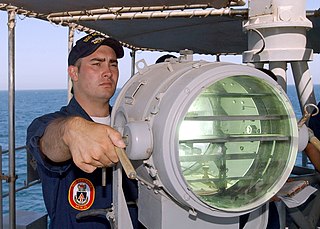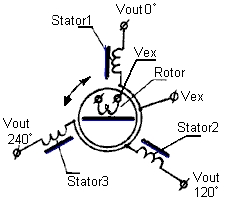
Analog television or analogue television is the original television technology that uses analog signals to transmit video and audio. In an analog television broadcast, the brightness, colors and sound are represented by rapid variations of either the amplitude, frequency or phase of the signal.

Chrominance is the signal used in video systems to convey the color information of the picture, separately from the accompanying luma signal. Chrominance is usually represented as two color-difference components: U = B′ − Y′ (blue − luma) and V = R′ − Y′ (red − luma). Each of these difference components may have scale factors and offsets applied to it, as specified by the applicable video standard.

A galvanometer is an electromechanical instrument used for detecting and indicating an electric current. A galvanometer works as an actuator, by producing a rotary deflection, in response to electric current flowing through a coil in a constant magnetic field. Early galvanometers were not calibrated, but their later developments were used as measuring instruments, called ammeters, to measure the current flowing through an electric circuit.

Lidar is a surveying method that measures distance to a target by illuminating the target with pulsed laser light and measuring the reflected pulses with a sensor. Differences in laser return times and wavelengths can then be used to make digital 3-D representations of the target. The name lidar, now used as an acronym of light detection and ranging, was originally a portmanteau of light and radar. Lidar sometimes is called 3D laser scanning, a special combination of a 3D scanning and laser scanning. It has terrestrial, airborne, and mobile applications.

Optical communication, also known as optical telecommunication, is communication at a distance using light to carry information. It can be performed visually or by using electronic devices. The earliest basic forms of optical communication date back several millennia, while the earliest electrical device created to do so was the photophone, invented in 1880.
A transducer is a device that converts energy from one form to another. Usually a transducer converts a signal in one form of energy to a signal in another.

A bar code reader is an electronic device that can read and output printed barcodes to a computer. Like a flatbed scanner, it consists of a light source, a lens and a light sensor translating for optical impulses into electrical signals.Additionally, nearly all barcode readers contain decoder circuitry analyzing the bar code's image data provided by the sensor and sending the barcode's content to the scanner's output port.

A synchro is, in effect, a transformer whose primary-to-secondary coupling may be varied by physically changing the relative orientation of the two windings. Synchros are often used for measuring the angle of a rotating machine such as an antenna platform. In its general physical construction, it is much like an electric motor. The primary winding of the transformer, fixed to the rotor, is excited by an alternating current, which by electromagnetic induction, causes currents to flow in three Y-connected secondary windings fixed at 120 degrees to each other on the stator. The relative magnitudes of secondary currents are measured and used to determine the angle of the rotor relative to the stator, or the currents can be used to directly drive a receiver synchro that will rotate in unison with the synchro transmitter. In the latter case, the whole device may be called a selsyn.

Laser Doppler velocimetry, also known as laser Doppler anemometry, is the technique of using the Doppler shift in a laser beam to measure the velocity in transparent or semi-transparent fluid flows or the linear or vibratory motion of opaque, reflecting surfaces. The measurement with laser Doppler anemometry is absolute, linear with velocity and requires no pre-calibration.

In surveying and construction, the laser level is a control tool consisting of a laser beam projector that can be affixed to a tripod. The tool is leveled according to the accuracy of the device and projects a fixed red or green beam about the horizontal and/or vertical axis.

A laser harp is an electronic musical user interface and laser lighting display. It projects several laser beams played the musician by blocking them to produce sounds which are reminiscent of a harp. The laser harp has been popularised by Jean Michel Jarre, and has been a high profile feature of almost all his concerts since 1981. British electronic musician Little Boots has used a similar instrument in concerts. The British electro jazz band 1201-Alarm feature a laser harp as a main aspect of their live show. Japanese musician and composer Susumu Hirasawa uses a laser harp in his concerts as well.
A transmission control unit or TCU is a device that controls modern electronic automatic transmissions. A TCU generally uses sensors from the vehicle as well as data provided by the engine control unit (ECU) to calculate how and when to change gears in the vehicle for optimum performance, fuel economy and shift quality.

A projection keyboard is a form of computer input device whereby the image of a virtual keyboard is projected onto a surface: when a user touches the surface covered by an image of a key, the device records the corresponding keystroke. Some connect to Bluetooth devices, including many of the latest smartphone, tablet, and mini-PC devices with Android, iOS or Windows platform.
A control valve is a valve used to control fluid flow by varying the size of the flow passage as directed by a signal from a controller. This enables the direct control of flow rate and the consequential control of process quantities such as pressure, temperature, and liquid level.

A photoelectric sensor, or photo eye, is an equipment used to discover the distance, absence, or presence of an object by using a light transmitter, often infrared, and a photoelectric receiver. They are largely used in industrial manufacturing. There are three different useful types: opposed, retro-reflective, and proximity-sensing (diffused).
A variable reluctance sensor is a transducer that measures changes in magnetic reluctance. When combined with basic electronic circuitry, the sensor detects the change in presence or proximity of ferrous objects.

Electronic Diesel Control is a diesel engine fuel injection control system for the precise metering and delivery of fuel into the combustion chamber of modern diesel engines used in trucks and cars.

Servos are small, cheap, mass-produced servomotors or other actuators used for radio control and small-scale robotics.
A reed receiver or tuned reed receiver (US) was a form of multi-channel signal decoder used for early radio control systems. It uses a simple electromechanical device or 'resonant reed' to demodulate the signal, in effect a receive-only modem. The encoding used is a simple form of frequency shift keying.
Most of the terms listed in Wikipedia glossaries are already defined and explained within Wikipedia itself. However, glossaries like this one are useful for looking up, comparing and reviewing large numbers of terms together. You can help enhance this page by adding new terms or writing definitions for existing ones.













